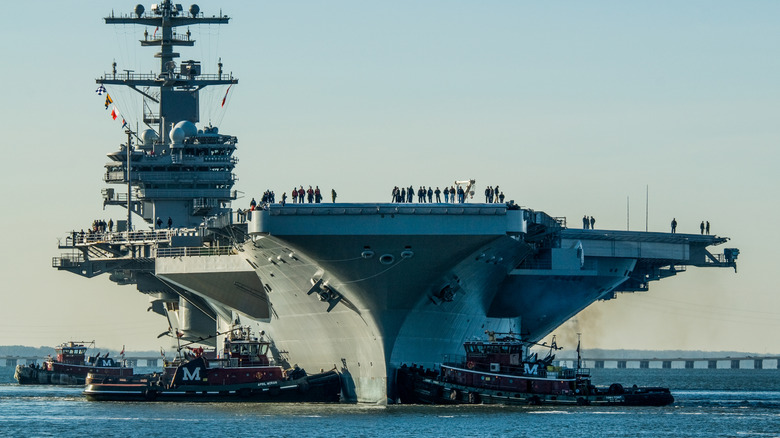Do US Aircraft Carriers Normally Carry Drones?
When it comes to naval superiority, the U.S. Navy is among the most dominant and imposing. The nation's fleet is made up of several vessels that can take on a variety of roles, from protecting the country from naval threats and deterring aggression to carrying out reconnaissance missions and sea control. The fleet's aircraft carriers are arguably the Navy's most iconic vessels. The Navy currently operates 11 aircraft carriers, each acting as a mobile landing, floating runway for the Navy's aircraft.
While these aircraft carriers, like the USS Gerald R. Ford (CVN 78), have proven to be quite effective at what they do, you may wonder if they usually carry drones. Well, the answer to that is currently no. However, given how rapidly technology has been growing, the military has been looking into ways of integrating such systems in the Navy. Interestingly, said integration has already begun, but not in the way you might expect.
The military already has several impressive drones
As you already know, the use of drones in the U.S. Military isn't a new thing. In fact, there are some highly advanced units in use, like the Lockheed Martin RQ-170 Sentinel, which made our list of the fastest military drones ranked by speed. One of the main advantages of using drones in the military is reducing risk to personnel, which every military wants. Additionally, using drones may reduce operational expenses, with the added benefit of ensuring precision strikes and real-time, high-resolution imagery and intelligence that aid in surveillance and reconnaissance.
With all this in mind, you could argue that it would be a sound decision to include drones among the many manned aircraft that aircraft carriers usually carry. Military analysts at the RAND Corporation brought up a similar point, saying that "The goal would be to use these technologies to increase the fleet's capabilities, capacity, survivability, and resilience." The Navy has started moving in this direction, gradually working toward integrating unmanned systems into carrier operations
The Navy has installed a drone control room in the USS George H.W. Bush
In 2014, the U.S. Navy tested Northrop Grumman X-47B in carrier operations on the USS Theodore Roosevelt (CVN-71), marking a significant milestone in an operation to incorporate more unmanned vehicles in the Navy through aircraft carriers. This landing followed a successful one that took place on the USS George H.W. Bush (CVN-77) a year earlier, a feat that had never been accomplished in naval aviation history.
Fast forward to this decade, and the U.S. Navy has installed an Unmanned Air Warfare Center (UAWC) on the USS George H.W. Bush. While this doesn't mean the aircraft carrier is carrying actual drones, it still marks a significant step toward that reality. The UAWC's focus will be Boeing's MQ-25A Stingray, a carrier-based refueling drone that can refuel fighter jets like the F-35C, with the Navy revealing that the long-term goal is to have all Nimitz- and Ford-class carriers have capabilities to operate the drone.
As of now, the MQ-25A is set to reach Initial Operational Capability (IOC) and deployment in the third quarter of fiscal year 2027. However, the Navy confirmed that it has been performing early test runs on the drone's prototype, the MQ-25A T-1. Some of the test runs have included deck handling testing on the George H.W. Bush (CVN-77).


